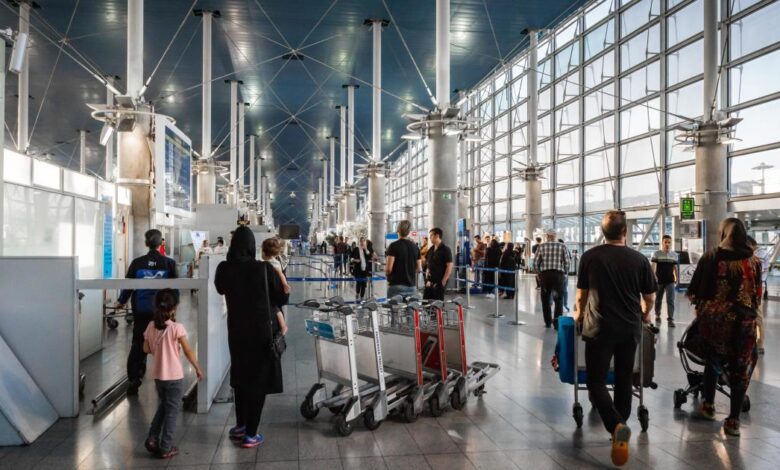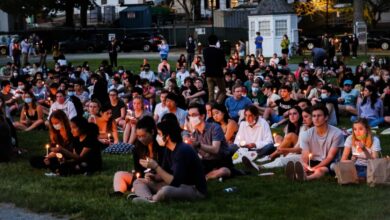Iranian Students’ Troubles Getting to the U.S. Threaten STEM Pipeline

[ad_1]
Sahar feels like she has fallen into a black hole.
The 26-year-old Iranian was accepted to an American doctoral program in biomaterials and biomedical engineering in 2020 but had to defer for a year because of the Covid-19 outbreak. This spring, she traveled to Pakistan for a U.S.-visa interview, but three months later, she still does not have the documents she needs to travel. Classes begin in just 10 days at the large public university in the South where she is enrolled. (The Chronicle is not identifying Sahar and her institution because she, like other Iranian students, fears that speaking publicly could jeopardize her chances of getting a visa.)
Sahar, who plans to work on vaccine research, would like to go see her family, who lives several hours outside of Tehran. Once she goes to United States, she won’t be able to return home until she finishes her studies, which could take five years or more. But if her visa were to come through at the last minute, going to say good-bye could jeopardize her travel to America. So she waits.
“I do not know what to do, I do not know how to plan,” Sahar said. “I am lost.”
Covid-19 has caused enormous unpredictability for international students around the globe. U.S. consulates are scrambling to issue student visas in time for the fall semester while grappling with a massive backlog. Limited international flights, vaccine requirements, and the spread of the highly contagious Delta variant add to the complications.
But Iranian students are in a special kind of limbo. The lack of official ties between the United States and Iran means that students must navigate pandemic-related travel restrictions to go to a third country for visa interviews. Security vetting compounds the delays. And American sanctions prohibit Iranian students from taking online classes from home if they cannot make it to campus this fall.
Some students, who already had to put their studies on hold for a year because of the pandemic, worry they could lose their admission offers or their funding if they can’t get to the United States soon.
“They have always been challenged,” said Ron Cushing, director of international services at the University of Cincinnati, which typically enrolls 30 to 40 new Iranian students a year. “This year, the challenges are greater.”
Breaks in the flow of students from Iran would be bad news for American higher education as well. Before Covid-19, 11,450 Iranian students were enrolled in American colleges, according to the Institute of International Education. Although that’s just 13th among countries that send students to the United States, Iran punches above its weight, especially at the doctoral level. Only three other foreign countries account for more Ph.D. graduates from American colleges, and Iranian students are especially prominent in technical and highly sought-after STEM fields.
They go on to feed the American talent pipeline, both inside and outside academe. According to the National Science Foundation, nine in 10 Iranian doctoral students plan to remain in the United States after graduation, at least for their first job or postdoctoral appointment, a higher stay rate than of any other country.
“There’s just something in the educational water there,” said Kenneth Reade, director of international student and scholar services at the University of Massachusetts at Amherst, which in a normal year enrolls as many as 45 new Iranian students. “Universities trip over each other to recruit these students.”
An Enduring Connection
The connection between the two countries in higher education has endured despite the breakdown in diplomatic relations. Back in the 1970s, Iran sent more students to the United States than any other country, although that ended with the Iranian revolution in 1979.
Still, American colleges continue to be viewed as the gold standard for many Iranian families, who hold education in high esteem. For most of the past two decades, the number of Iranian students in the United States increased rapidly, although that growth stopped after former President Donald J. Trump included Iran in a controversial travel ban that blocked the entry of citizens from a half-dozen predominantly Muslim countries. (Iranian students were subsequently given a special exemption from the ban, which President Biden has since lifted altogether.)
“When we got offers from universities in the U.S., we thought we’d achieved something really great,” Sahar said. The United States offers cutting-edge laboratories and equipment that aren’t available in Iran.
Visa issuances to Iranians had actually picked up in May and June, when 280 and 447 visas were issued, respectively. That progress raised expectations, students said.
But in recent weeks, few students among the tight network of those who go abroad report receiving visas. In July, just 21 student and exchange visas were issued by the U.S. Embassy in Armenia, a major funnel for Iranian students, said the students, who have started a petition to urge the U.S. State Department to speed processing.
Because the United States does not have an embassy in Iran, students travel to consulates in neighboring countries for required in-person visa interviews. Currently, all but one of those outposts have interview wait times of “999 calendar days” or are accepting visa appointments on an emergency basis only. Some, such as consulates in Turkey, are not processing visas for people who do not reside in that country.
Only consulates in Pakistan say they have available student-visa appointments in the coming weeks, with wait times of 23 days in Karachi and 31 days in Islamabad.
For her visa appointment, Sahar flew to Islamabad at a cost of $1,000, far more than the average Iranian family makes in a month. Alireza Asadi, who won a full scholarship to Michigan Technological University, traveled to Pakistan, too. Because of a lack of affordable flights, he took a 10-hour taxi ride from Karachi to the Iranian border to return home.
His visa is now in administrative processing, an onerous screening process by multiple intelligence agencies that most Iranian applicants go through, even before the pandemic. “There is no reason to be sensitive because my work is in a very safe field,” said Asadi, who studies cardiovascular engineering.
His academic supervisor has tried to reassure him by telling him he can arrive late for the semester, which begins later this month. Still, he worries.
Sara, a doctoral student at a public research university in the Midwest, hasn’t even been able to schedule a visa appointment. She has already deferred her admission until spring, but she has become increasingly anxious that she won’t be able to get an appointment in time. Then she could lose her funding, she said.
Sara has already spent much of her savings on college applications — she was accepted by five doctoral programs — and on English-language exams and the GRE. She doesn’t know what happens next. Her hair is falling out because of the stress, she said. “I will lose this opportunity. I will lose my future.”
Studying remotely is not an option. National-security, economic, and scientific sanctions imposed on Iran by the United States prevent students and scholars from Iran from accessing international academic databases, participating in virtual conferences, or even taking classes via Zoom.
That leaves deferral as the only option. More Iranian doctoral students deferred admission last year than students from any other country, a survey by the Council of Graduate Schools found.
At UMass, only 10 Iranian students chose to enroll last fall because of Covid. Of that number, four are still waiting for their visas, more than a year after they initially applied, Reade said.
Still, Reade is reluctant to blame the slow processing of Iranian student visas on the pandemic. Even with Covid’s complications, Iranian students typically wait four to six months for their visas due to administrative processing, he said. Deferrals are commonplace, and students admitted for fall often don’t arrive until spring. “In many ways,” he said, “this year is no different.”
Dan Bauman contributed to this article.
[ad_2]
Source link






